
GAZ or Gorkovsky avtomobilny zavod is a Russian automotive manufacturer located in Nizhny Novgorod, formerly known as Gorky (Горький) (1932–1990). It is the core subsidiary of GAZ Group Holding, which is itself part of Basic Element industrial group. JSC Russian Machines is the controlling shareholder in OAO GAZ.
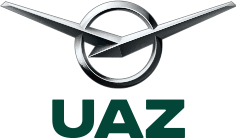
UAZ or Ulyanovsky Avtomobilny Zavod is an automobile manufacturer based in Ulyanovsk, Russia, which manufactures off-road vehicles, buses and trucks. It has been part of the Sollers automotive group since 2000.
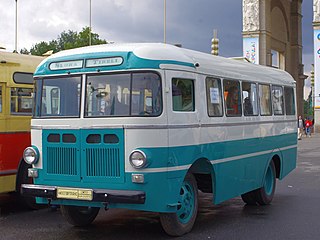
The Riga Autobus Factory was a factory in Jelgava, Latvia, making vans and minibuses under the brand name Latvija.

The Lada Оkа is a city car designed in the Soviet Union in the later part of the seventies by AvtoVAZ. It entered production in 1988 powered by a 644 cc (39.3 cu in) SOHC two-cylinder engine. While developed at AutoVAZ by a team led by Yuri Kuteev, no production models were built there. Instead, manufacturing was outsourced to SeAZ factory in Serpukhov and ZMA in Naberezhnye Chelny. Massive plans were in place for a new plant in Yelabuga, but these failed to materialize. The car was also produced in Azerbaijan by the Gyandzha Auto Plant. The name comes from the Oka River in Russia upon which Serpukhov is situated.

The Volkswagen Type 2 is a forward control light commercial vehicle introduced in 1950 by the German automaker Volkswagen as its second car model. Known officially as the Transporter, Kombi or Microbus, or, informally, as the Volkswagen Station Wagon (US), Bus, Camper (UK) or Bulli (Germany), it was given the factory designation Type 2 as it followed – and was initially derived from – Volkswagen's first model, the Type 1 (Beetle).

ZAZ Zaporozhets was a series of rear-wheel-drive superminis designed and built from 1958 at the ZAZ factory in Soviet Ukraine. Different models of the Zaporozhets, all of which had an air-cooled engine in the rear, were produced until 1994. Since the late 1980s, the final series, ZAZ-968M, was replaced by the cardinally different ZAZ-1102 Tavria hatchback, which featured a front-wheel drive and a more powerful water-cooled engine.
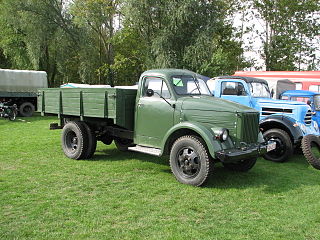
The GAZ-51 was a Soviet truck manufactured by GAZ. Its first prototypes were produced before the end of World War II, and the truck ended up using a heavily modified version of the Studebaker US6 cab, which was supplied to the Soviet Union in large quantities with the Lend-Lease agreement, although the chassis was completely new.

The Volga is an executive car that originated in the Soviet Union to replace the GAZ Pobeda in 1956. Their role in serving the Soviet nomenklatura made them a contemporary cultural icon. Several generations of the car have been produced.

The GAZ-M20 "Pobeda" is a passenger car produced in the Soviet Union by GAZ from 1946 until 1958. It was also licensed to the Polish Passenger Automobile Factory and produced there as the FSO Warszawa. Although usually known as the GAZ-M20, an original car's designation at that time was just M-20: M for "Molotovets".
The automotive industry in the Soviet Union spanned the history of the state from 1929 to 1991. It started with the establishment of large car manufacturing plants and reorganisation of the AMO Factory in Moscow in the late 1920s–early 1930s, during the first five-year plan, and continued until the Soviet Union's dissolution in 1991.

The Moskvitch-408 series is a small family car produced by the Soviet car manufacturer MZMA/AZLK between 1964 and 1975. The first prototype was made in 1960.

The Moskvitch 412 is a small family car produced by Soviet/Russian manufacturer MZMA/AZLK in Moscow from 1967 to 1975, and by IZh in Izhevsk from 1967 to 1982. It was a more powerful and prestigious version of the M-408 model, offering more features for a higher price.
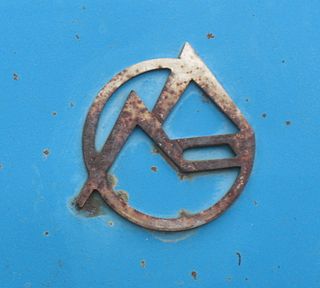
ErAZ or Yerevanskiy Avtomobilny Zavod, was an Armenian automobile manufacturer in Yerevan, Armenia, mostly known for producing the van RAF-977K from 1966 to 1996. Plans to establish the ErAZ factory came about on December 31, 1964, by the Council of Ministers of the Armenian Soviet Socialist Republic. The original staff were trained at the Riga Autobus Factory in Latvia and UAZ in Russia. ErAZ was privatized in 1995, and declared bankruptcy in 2002.

The ZIL-4104 was a limousine built by ZIL from the late 1970s to the early 1980s, when it served as the transport of the elite of the Soviet Union. It is estimated that no more than fifty cars were produced each year.

The GAZ-24 "Volga" is a car manufactured by the Gorky Automobile Plant from 1970 to 1985 as a generation of its Volga marque. A largely redesigned version – GAZ-24-10 – was produced from 1985 to 1992. The Belgian-assembled rebadged models were sold as Scaldia-Volga M24 and M24D for the Western European market.

The GAZ M21 Volga is an automobile produced in the Soviet Union by GAZ from 1956 to 1970. The first car to carry the Volga name, it was developed in the early 1950s. Volgas were built with high ground clearance, rugged suspension, strong and forgiving engine, and rustproofing on a scale unheard of in the 1950s.
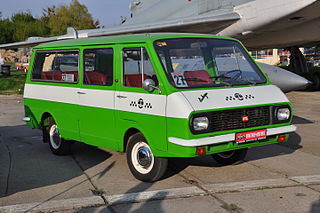
The RAF-2203 Latvija is a cabover van designed and developed by Rīgas Autobusu Fabrika from 1976 to 1997. They were widely used throughout the USSR as fixed-run taxis (marshrutkas), medical cars, used for trade and as a special services vehicles. It was the successor of the RAF-977.

The UAZ-452 is a family of four wheel drive off-road vans and light trucks with body-on-frame construction and cab over engine design, built by the Ulyanovsk Automobile Plant (UAZ) since 1965. Originally designed for the Soviet military, since 1985 the vans received updates: more modern engines and internationally compliant lighting, as well as new model numbers, UAZ-3741 for the standard van, while (crew-cab) trucks mostly starting with UAZ-3303, often with one or two extra digits specifying the version. From 1997, bigger UAZ-33036 truck variants with a 25 cm (10 in) longer wheelbase, and taller soft-top roof bows and drop-sides were added.

The Automotive industry in Ukraine was established during the Soviet times and until fall of the Soviet Union was an integral part of automotive industry of the Soviet Union. The first Ukraine-based motor vehicle brands were established in the late 1950s.
The ZMZ-24 was an automobile engine produced by Zavolzhye Engine Factory in the Soviet Union.



















